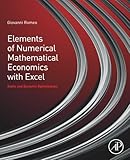Elements of Numerical Mathematical Economics with Excel : Static and Dynamic Optimization / Giovanni Romeo
Material type: TextPublication details: London, United Kingdom Academic Press (An Imprint of Elsevier) 2020Description: vii, 808p. : ill. ; 23cmISBN:
TextPublication details: London, United Kingdom Academic Press (An Imprint of Elsevier) 2020Description: vii, 808p. : ill. ; 23cmISBN: - 9780128176481
- 23rd Ed. 519.6 ROM
| Item type | Current library | Collection | Call number | Status | Notes | Date due | Barcode | |
|---|---|---|---|---|---|---|---|---|
| Reference Book | VIT-AP General Stacks | Reference | 519.6 ROM (Browse shelf(Opens below)) | Not for loan | MATH | 019409 |
It includes Index.
Elements of Numerical Mathematical Economics with Excel: Static and Dynamic Optimization shows readers how to apply static and dynamic optimization theory in an easy and practical manner, without requiring the mastery of specific programming languages that are often difficult and expensive to learn. Featuring user-friendly numerical discrete calculations developed within the Excel worksheets, the book includes key examples and economic applications solved step-by-step and then replicated in Excel.
After introducing the fundamental tools of mathematical economics, the book explores the classical static optimization theory of linear and nonlinear programming, applying the core concepts of microeconomics and some portfolio theory. This provides a background for the more challenging worksheet applications of the dynamic optimization theory. The book also covers special complementary topics such as inventory modelling, data analysis for business and economics, and the essential elements of Monte Carlo analysis.
Practical and accessible, Elements of Numerical Mathematical Economics with Excel: Static and Dynamic Optimization increases the computing power of economists worldwide. This book is accompanied by a companion website that includes Excel examples presented in the book, exercises, and other supplementary materials that will further assist in understanding this useful framework.
Key Features
Explains how Excel provides a practical numerical approach to optimization theory and analytics
Increases access to the economic applications of this universally-available, relatively simple software program
Encourages readers to go to the core of theoretical continuous calculations and learn more about optimization processes
There are no comments on this title.

